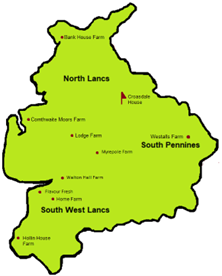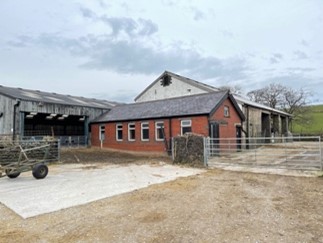The Myerscough College Ag Net Zero Challenge – Handleys
Land management is amongst the largest contributors to climate change and there is an urgency for agriculture to transform from being a net emitter of carbon (CO2e) to a net sequester of carbon (CO2).
Carbon Farm Audit #8
Courtesy of Malcom, Marty and Mick Handley
The Myerscough College Ag Net Zero Challenge is part of The Lancashire Colleges’ Strategic Development Fund Pilot, supporting colleges and local employers to work together to create a skilled workforce for a future low-zero carbon economy.

Farm Profile
The Handley’s from Croasdale House Farm in Slaidburn, Lancashire, volunteered to participate in the Myerscough College Ag Net-Zero Challenge. They undertook a whole farm carbon audit to identify areas of improvement within their farm business to reduce carbon emissions.
Croasdale House Farm
Slaidburn
Clitheroe
tHE CARBON AUDIT

A carbon audit is an assessment of the emissions of carbon dioxide equivalents (CO2e) produced by each enterprise within a business and, where possible, looks at the sources of sequestration within the business. The carbon audit at Croasdale House Farm was carried out by Carbon Metrics – a company that specialises in analysing and interpreting existing data and generating a targeted management plan to show how net-zero strategies can be achieved. The farm audit is calculated by using a carbon toolkit. There are currently over 70 toolkits available with no standard industry requirements for data. Therefore, in this case study, we used the average of two carbon audit calculators, Agrecalc and Cool Farm Tool, to produce the results.
Strengths
Pasture Management and Carbon Sequestration. The farm currently benefits from high levels of peatland carbon storage on the upland grounds that are reserved for sheep to graze. By farming in a less intensive system across this fragile habitat enables the rate of peatland degradation to be minimised allowing it to remain as a stable store of carbon. Additionally, by sustainably managing the peatlands at Croasdale House Farm enables the nature capital of the farm to be built up as the peatlands support a wide array of fauna across different habitats and enables a biodiversity net gain.
Countryside Stewardship Scheme. Currently Croasdale House Farm enjoys a large Countryside Stewardship scheme due to the farm’s large area of roughland grazing. These subsidies enable the farm to graze the upland areas less intensely in order to preserve the peatland so as to help sequester carbon dioxide. Furthermore, the scheme allows the farm to help focus on regenerative agriculture practices and deliver gains in natural capital.
Areas for Consideration
Carry out a Soil Carbon test
Carrying out a loss on ignition test will help to verify the amount of Soil Carbon in your current soils. As the programs used in auditing use averages to work out soil sequestration, this action is key to verify that soil carbon is being built up. This needs to be done yearly in order to show the Soil Carbon build up.
Improved forage and soil management
Look at the management practices on the silage pastures and adopt regenerative farming techniques. These measures could include the controlled use of nitrogen fertilisers to match inputs to field conditions more closely; increased use of organic residues, such as livestock manures and more cultivation of legumes, which fix nitrogen in the soil and reduce the need for fertilisers.
Carbon Opportunities
Peatland Carbon Credits and Circular Economy
Peatlands have the potential to be a natural solution to reducing greenhouse gas emissions. They hold a vast stock of carbon in their soils and can add more by sequestering carbon from the atmosphere. But this natural carbon capture and storage ability can only happen if peatland habitats are healthy and functioning. To get to that state many areas of degraded and damaged peatland, which are currently losing carbon, need to be restored.
The peatlands have not yet been considered as part of the carbon balance within this audit. With soil testing to show the amount of carbon sequestration year on year, this could be used to show if the farm is Net Zero and what any potential credits may be in the future either as individual farm transactions or as part of a circular economy with other farms in the local area.
Benefits for the Business
Improved return on investment. By following the areas of consideration and the mitigation measures, the farm can expect to see a better return on crop costs and fuel usage. It will also see the amount of CO2e emitted fall further, helping to achieve Net Zero. The farm could look to invest in renewables, but this would only help a small proportion of the way to reach Net Zero, and further work on fuel and fertiliser needs to be carried out in order to significantly reduce the farm’s carbon output first.
Leading the way with Carbon Emissions. The farm has a very real possibility of leading the way in showing how agriculture can help lead the way as part of the path to Net Zero. As opportunities around carbon credits and soil sequestration could become monetised, the farm is in an enviable position to be at the forefront of these concepts and pilots which should not only add value to the business but also help open new areas of income as the industry transitions away from direct payments.
Leading the way in delivering the sustainable farming agenda
The Handley’s are leading the way in the Forest of Bowland in spreading the sustainable farming agenda. The farm plays host to students from the Bowland High School across the year to help broaden their experience on extensive farming techniques and help them achieve their BTech Level 2 in Country and Environment. The Handley’s involvement gives students vital hands-on experience in both sustainable farming practices as well as providing them much needed insight into the land management and forestry as well as biodiversity recovery.
Furthermore, the farm actively engages in helping deliver environmental recovery. The farm is part of a large Countryside Stewardship that focuses on maintaining the nearly some 1000 hectares of upland (includes peatland) through extensive grazing systems with its Belted Galloway herd. The farm works with conservationists and its landowners to develop sustainable farming strategies to maximise the ecological well-being of the landscape, through continual improvements in the health of both its soils and areas of upland peat.


Subscribe!
Please enter your email below to keep up-to-date with the AG Net-Zero Challenge
